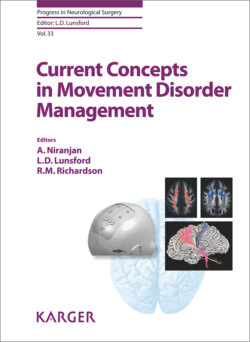Читать книгу Current Concepts in Movement Disorder Management - Группа авторов - Страница 36
Basal Ganglia Dysfunction in Dystonia
ОглавлениеA strong argument in favor of basal ganglia involvement in dystonias is that dystonia can be treated with neurosurgical interventions aimed at the basal ganglia. Thus, ablative procedures or deep brain stimulation (DBS) of GPi or STN are highly effective in cases of advanced medically intractable dystonia. GPi-DBS has been shown to work particularly well in cases of primary generalized dystonia, tardive dystonia, and myoclonus-dystonia, and less so in secondary dystonias (reviewed in ref. [12]). Although exceptions exist, the full effectiveness of these interventions unfolds over long periods of time (often months), suggesting that the mechanism of action of surgical interventions is indirect, perhaps through slow reshaping of synaptic strengths in brain circuit elements downstream from the basal ganglia.
Pharmacologic evidence supports the role of basal ganglia disturbances in dystonia. Most of this evidence involves abnormalities of dopaminergic transmission (recently reviewed in ref. [13]). Thus, dopamine receptor antagonists, such as typical neuroleptics, can lead to acute or tardive dystonia. This has mostly been seen with drugs that occupy D2-family dopamine receptors. Other drugs can also cause dystonia, but with much lower frequency. A link between abnormally low dopaminergic transmission and dystonia is also suggested by the fact that genetic disorders that affect dopamine metabolism commonly lead to dystonia, as has been seen in patients with mutations in genes encoding enzymes that are essential for dopamine synthesis, such as GTP cyclohydrolase or tyrosine hydroxylase deficiency (DYT5). Although these disorders obviously affect the synthesis of dopamine and other catecholamines throughout the brain, dystonia is usually attributed to dysfunction of dopaminergic transmission in the striatum. Exposure of animals to toxins that damage dopamine-producing neurons (specifically MPTP) can also lead to a transient state of dystonia. Finally, a link between a (presumably striatal) dysfunction of dopaminergic transmission and the emergence of dystonia is suggested by the fact that dystonia can be a sign of early PD, or a side effect of dopaminergic antiparkinsonian therapy. Both phenomena are more common in cases of young-onset PD, suggesting that synaptic plasticity may be necessary for the emergence of dystonia.
In addition to the stated evidence favoring dopaminergic dysfunction, in at least some cases of dystonia cholinergic abnormalities have been described. In fact, there has been a long tradition of using anticholinergic agents in the treatment of dystonia. More recently, abnormalities of cholinergic transmission, or of the interaction between the cholinergic and dopaminergic systems in the striatum, have been described in genetic mouse models of DYT1 dystonia (e.g., ref. [14]).
Recordings from the basal ganglia in patients undergoing neurosurgical treatment of dystonia have shown that the basal ganglia output nuclei show reduced overall firing rates, while other abnormalities, such as increased bursting, or the presence of abnormal synchrony and low-frequency oscillations is generally similar to what is observed in patients with PD (for instance, ref. [15]). There is no information available about changes in other portions of the basal ganglia thalamocortical circuitry related to dystonia. Given the protracted effects of neurosurgical interventions, it is likely that synaptic plasticity in brain regions downstream from the targets of intervention are involved in the pathophysiology of dystonia.
